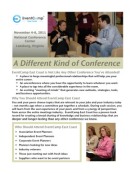 During the session on participant-driven events, participants looked at strategies used to create events like EventCamp™, focusing on the strengths, weaknesses, and interests of those involved as primary tools in planning the event.
During the session on participant-driven events, participants looked at strategies used to create events like EventCamp™, focusing on the strengths, weaknesses, and interests of those involved as primary tools in planning the event.
Participants outlined their interests and stated what they would like to learn about the Unconference model, its success rate versus other models, the extent to which the democratic process of the Unconference works, and how to execute a participant-driven event “when participants aren’t very driven.”
Adrian Segar (@ASegar) described the goals and strategies of the Conferences That Work participant-driven model: its focus is to create the best possible experience for each person at the conference. This represents a departure from other Unconference events, where hosting organizations or corporations work to produce a strategy or plan based on pre-defined goals. The Unconference structure used at EventCamp revolves around individual development that is maximally useful to each person who attends.
Other Unconference models, such as the Open Space model, are able to handle large groups of people. The group sits in a circle and participants are invited to come to the center and say, “I want to have a session about x.” These requests are placed on a big chart of rooms and times. The advantage of the Open Space model is that it can work for thousands of people or a few, and can be executed in a day or a few days with little preparation time. The disadvantage is that participants don’t necessarily get to know each other.
The Open Space model is much more task-oriented, and works well for people who might already be familiar with one another. However, it doesn’t work well for introverts, Segar said. “I have some friends that run an Open Space event with 150 people,” he said. “There was a guy there who was an expert in the area and had a huge amount to give, but was very introverted, and there was no mechanism to bring people in. They lost the input of that person.”
A participant asked Segar about the maximum capacity of a roundtable session; he referred to the answer he gives in his book, which explains how to set up roundtables for 100 people. Two roundtables with 50 people each enable each participant to use the “buddy system.” As a result, by the end of the process each participant knows everyone else very well. Segar said this represents a scaling issue: such an event will not work the same way with 2,000 people. Thus, it is necessary to create mini versions of the roundtable discussions.
Participants discussed Renaissance Weekend, a private, high-end conference of about 3,000 people that attracts individuals like Jimmy Carter, as well as CEOs of Fortune 500 companies. The event is very confidential, as well as very expensive. “This event gives people a nice environment, confidentiality, and peers, which are very valuable,” Segar said. “But what I’m trying to do is create that at a more mundane level.”
Participants talked about crowd-sourcing, discussing how it might be possible to determine a schedule before the actual conference takes place, but do so in a diplomatic way, as seen at the Unconference. Segar said he has attempted this through wiki websites, giving people a place to say what they think should go on at the conference. However, only a small proportion of attendees fill these out voluntarily. When people are forced to respond, such as through asking this question at registration, they write the first three things that come to mind; they are busy, and their minds are on other things, Segar said.
Some participant groups can be very definite in creating topics for a schedule, and setting out what they want to learn. “Certainly, technical people come up with specific things,” Segar said. “I need to know about x and need to know about y.” For the past 20 years, he has had the opportunity to compare what people say they want to do with what actually happens at the event. The best program committees can predict about 50% of what actually happens in sessions, which means during the event, half the sessions are not optimal for the participants. Segar said this is why he establishes the schedule at the beginning of the event.
A participant added that many people came to EventCamp with no idea of what would go on during the conference. On the strength of the first EventCamp, the participant said he put “utter blind faith” in what they would be doing during this event.
Segar said he puts some information on the EventCamp website, and a description of the Unconference process can be found on his own site. But most people don’t make decisions before the event. “You can see from the evaluation forms that people are happy with the sessions we had here because they chose them, and are able to take ownership,” he said.
Participants continued their discussion of scalability, considering whether it would be possible to extend a conference like EventCamp over four or five days. Segar said he would not do more than three and a half days, because the event itself is pretty intense. The Internet allows people to sit and get extensive information delivered to them. “So what’s left?” Segar asked.
The most important element of conferences is the face-to–face meetings, which are not replicable through a virtual outlet. People are interested in the content—that’s why they come to the event—but they are interested in content that is personally useful, Segar said.
Sessi on summaries produced by The Conference Publishers, the world’s leading specialists in capturing and repackaging conference content.
on summaries produced by The Conference Publishers, the world’s leading specialists in capturing and repackaging conference content.









